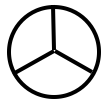Home > Topdrawer > Fractions > Misunderstandings > Fractions as a double count
Fractions as a double count
Tasks such as these are usual in classrooms.
| Colour two thirds of this shape. |
What fraction of this shape is shaded? |
Students learn to connect a part-whole area diagram with the written fraction by thinking, "The denominator tells how many parts, and the numerator tells how many are shaded."
While this is a useful basic strategy, it is problematic for several reasons.
- The written fraction is seen as a pair of whole numbers, each recording the count of something different: a 'double count'.
- Many students believe this double count to be the actual definition of a fraction.
- A fraction is not comprehended as a single number, having a value like other numbers.
- The double count cannot be generalised to all situations, such as "Share two pancakes equally among four people."
- Students can lose sight of the whole and interpret a part-whole situation as a ratio, especially when working with fractions of collections.
Wrong number
The double-count perception of fractions can be detected in student responses to basic tasks.
Expanding the view
To avoid the limitations of the double-count perception of fractions, students need to expand their view of fractions beyond the basic part-whole model.
Fraction fiddle
The digital learning object illustrates the relationship between the part-whole model of a fraction and the value of the fraction, by representing its position on a number line.


